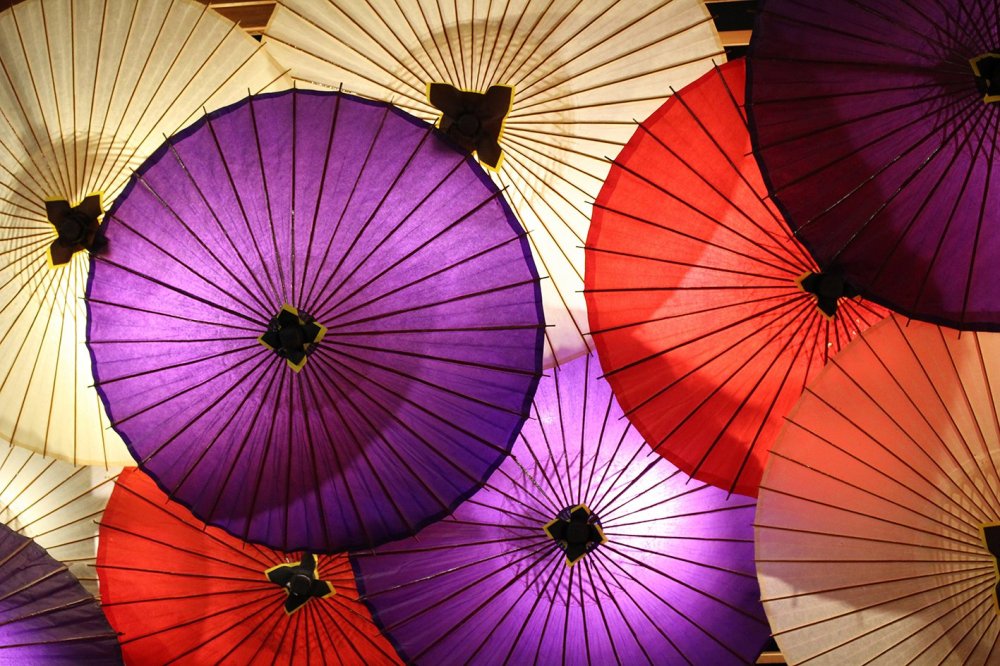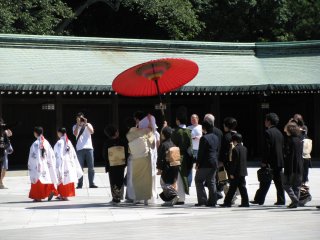Japan is a country where the most modern of things organically coexist with traditional ones. I’ve already written about the changeable weather in Japan is, and so with that in mind, the practicality of a kasa umbrella is obvious.
No umbrella when you need one, don't worry, they can be purchased quite easily. All small shops offer cheap plastic ones for about JPY300-800. These transparent umbrellas are ubiquitous though black and colored ones are also popular. Parasols protecting from the sun are also common with many fashion-conscious people making use of laced ones and even ones with anime prints.
Silk umbrellas - kinugasa
About 1500 years ago, umbrellas were introduced into Japan from China and were a silk awning stretched over a wooden frame set on a long stick. Such umbrellas was called kinugasa, meaning "silk umbrella." Red silk was a symbol of Imperial power and these kinugasa, decorated with family emblems and colours, served as a status symbol for their users and were carried over their masters' head by servants. Individual umbrellas appeared in the Kamakura period (1185-1333), but were still quite large. The umbrella also began to be used as a ceremonial accessory - Shinto priests considered kinugasa to be the temporary abode of the kami deities.
Japanese umbrellas - Wagasa
At the beginning of the Edo period (1600-1868), umbrellas entered the everyday life of ordinary people. By that time, kinugasa had changed significantly - they became lighter and more convenient. For these umbrellas, oiled paper was used, and importantly, began to be folded. Hence, the Japanese wagasa umbrella was born.
Wagasa were made from natural materials, such as bamboo, washi paper and wood. Making them though was a laborious process. A finished product required several months. First, the craftsman verified the bamboo rib lengths, then pasted the ribs with paper treated with persimmon juice. Next, the paper top was covered with paint and smeared with oil, and the wooden parts were covered with varnish before finally being sun dried. Dried after each use, wagasa made in this way could serve for up to ten years.
Umbrella variety
There are different types of wagasa: bangasa are large umbrellas sans ornamentation usually used by men; higasa are sun shade parasols; honshiki nodategasa are large umbrella used for outdoor occasions, for example, during a tea ceremony; ehigasa, umbrellas decorated with birds and floral motifs, were part of the of the capital's well-t-do accessories while maigasa are light umbrellas used for classical Japanese dance.
With the introduction of European umbrellas into Japan during the Meiji period (1868-1912), the demand for traditional wagasa umbrellas began to decline. Despite this, wagasa remain one of the main symbols of traditional Japanese culture. You'll find them in traditional wedding processions, at tea ceremonies held outdoors and at festivals. Wagasa are also used by maiko and geisha as well as in kabuki theatre.
The most famous centre of wagasa production is the Kano district in Gifu, where wagasa has been produced since the mid-18th century. In Kyoto, many artisans keep the craft of wagasa production alive by passing on their skills to the next generation.
















































